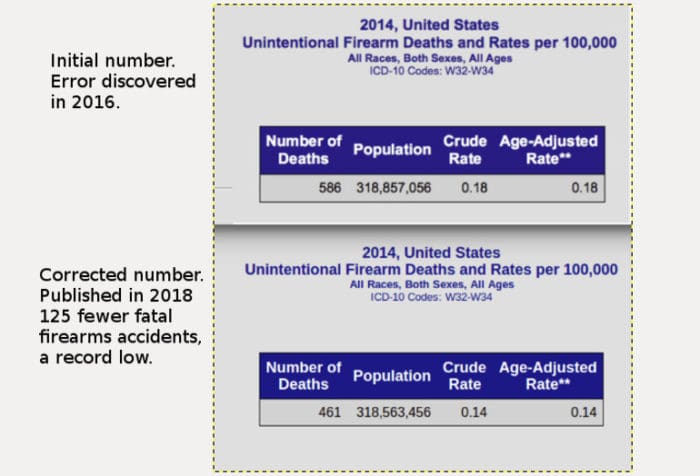In 2015, the Centers for Disease Control (CDC) made an error in the number of fatal firearms accidents they reported that occurred in 2014. It was so large that it was obvious.
The number of fatal firearm accidents had been falling significantly, but in 2014, they suddenly and inexplicably jumped by over 25%. Most of the increase was in one state, Tennessee. Dr. John Lott noticed the error in January of 2016, and brought it to the attention of the CDC.
In January 2016, Dr. John Lott contacted the CDC to alert them to a mistake in their numbers for 2014 on accidental gun deaths. The total was clearly a 100 larger than it actually was (the error arose because of mistakes in Tennessee’s data, and the mistake was so large it noticeably impacted the national number accidental deaths that year, raising the reported number from 486 to 586). Finally, in October 2016, the CDC acknowledged their error, but they never corrected the data on the website. This error is so large that it noticeably affects even five-year averages in accidental gun deaths. Unfortunately, since they never made the corrections, others are making mistakes when they use the data.
Now even reputable organizations such as the National Safety Council are using the erroneous data and drawing incorrect conclusions. Their new report “Injury Facts — 2017 Edition” shows that the number of fatal firearm accidents fell from 586 in 2014 to 489 in 2015 — a 17% drop. In fact, there was a slight 0.6% increase from 486 to 489. New headlines incorrectly claim that “Accidental shootings at all-time low of 489, gun sales highest ever,” when in fact 2014 was the lowest year on record and the numbers went up very slightly in 2015.
While the CDC acknowledged the error, they failed to correct it. Finally, in 2018 — two and a half years after being notified — they have corrected the mistake, but the error was even greater than originally thought. Instead of inflating the number of fatal firearm accidents by 100, the total was erroneously increased by 125.
It’s not clear how the error occurred or why it took the CDC more than two years to correct the total. Very likely, the reason was bureaucratic inertia.
In October of 2016, CDC put out a notice that the 2014 data was bad. Users of the data were forewarned that the numbers were unreliable. In a large bureaucracy, it takes time to check and recheck everything. No one wants to admit an error in an organization whose major stock in trade is its credibility.
That the correction crossed the boundary of a presidential election is intriguing. It’s not proof of institutional bias, but it may be an indicator. President Obama was resolutely against an armed population. President Trump has openly supported Second Amendment freedoms.
The CDC has been chastised by Congress for institutional bias against an armed population before. The CDC buried data — or at minimum, didn’t promote it — that supported claims of large numbers of defensive gun uses.
Selection bias is one of the most difficult things for researchers to fight. People tend to see information they agree with and ignore information they disagree with.
Researchers and bureaucrats are people, too. Inside the CDC, there seems to be a bias against data that supports the advantages of an armed population.
©2018 by Dean Weingarten: Permission to share is granted when this notice and link are included.
